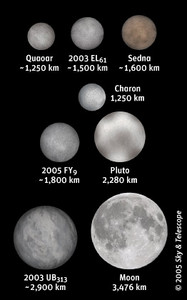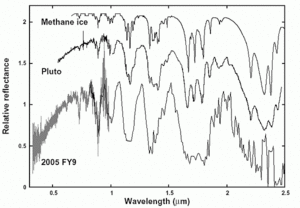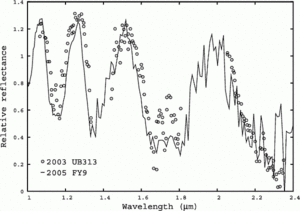TNG and WHT Observations Prove that the Large Trans-Neptunian Object 2005 FY9 is Very Similar to Pluto
Visible and near-infrared spectroscopic observations carried out on August 1st 2005 by a group led by the ING-IAC astronomer Javier Licandro 1 using the Telescopio Nazionale Galileo (TNG) and the William Herschel Telescope (WHT) simultaneously show that the recently discovered trans-neptunian object (TNO) 2005 FY9 is very similar to Pluto. Results have been published in the journal Astronomy & Astrophysics (Licandro et al., 2006, A&A, 445, 35L).
2005 FY9 is the third brightest known TNO, after 2003 UB313 and Pluto. Although discovered early in 2005 by USA astronomers M. Brown and co-workers, the discovery wasn't reported until July 29th. The size of 2005 FY9 is 0.7 times that of Pluto approximately. The semi-major axis of its orbit is 46 Astronomical Units (AU, 1 AU=149,597,892 kilometres), the perihelion distance is 39 AU and the inclination of the orbit is 29°. These values are typical of the classical TNO family.

Figure 1. The size of the largest objects known in the outer Solar System compared with the
size of the Moon.
Near-infrared spectroscopy was obtained using the NICS spectrograph on the TNG and visible spectroscopy was obtained
using the
ISIS spectrograph on the WHT. The complete visible and near-infrared spectrum is shown in
Figure 2 and compared with the spectrum of Pluto and that of pure methane ice.
Figure 2 clearly shows that the spectra of both TNOs are very similar.
They are dominated by strong absorption bands produced by methan ice. In fact, the absorption bands in the
spectrum of 2005 FY9 are deeper than in the spectrum of Pluto as a result of the larger abundance
of methane ice in 2005 FY9. Also the colour of the surface of the TNO is red (indicated by the
slope of the spectrum), similar to that of Pluto. This shows the presence of complex organic compounds in the surface.

Figure 2. The spectrum of 2005 FY9 compared with the spectrum of Pluto and that of pure methane ice.
Notice the strong methan ice absorption bands present in the spectrum of both TNOs.
The discovery of a Pluto 'twin' in the trans-neptunian belt is relevant as Pluto is the only known TNO possessing a small atmosphere. The similar size and surface composition of 2005 FY9 are facts that suggest it can also have such a tenuous bound atmosphere.
Until now only one known TNO, Pluto, showed the presence of strong methan ice absorption bands in the spectrum. However, apart from 2005 FY9, recently these bands were also observed in the spectrum of the largest yet known TNO, 2003 UB313 (Brown et al., 2005, ApJ, 635, 97). As shown in Figure 3, the near infrared spectrum of 2003 UB313 is very similar to that of 2005 FY9.

Figure 3. Near infrared spectrum of 2005 FY9 obtained by
Licandro et al. (2006)
compared with that of TNO 2003 UB313 from
Brown et al. (2005)
. The similarity of both spectra shows that the surface composition of both objects must be also similar.
The discovery that 2005 FY9 is very similar to Pluto provides astronomers with a new and exciting laboratory for the study of volatile mixing and transport, atmospheric freeze-out and escape, ice chemistry, and nitrogen phase transitions in Pluto-like objects.
Notes:

